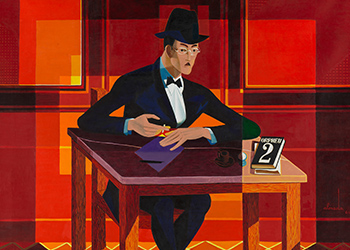Fernando Pessoa in the Reina Sofía Museum

“All art is a form of literature as all art is saying something”, signed off Álvaro de Campos in 1936 in the Presença magazine, one of the most influential Portuguese literary journals of the 20th century. This is the starting point for this selection that brings together around 160 works by various artists such as Almada Negreiros, Amadeo de Souza-Cardoso, Adriano de Sousa Lopes, Mário Eloy, Julio (Saúl Dias), Sonia Delaunay, among others, in an approach to the leading Portuguese aesthetic trends of the 20th century. Curated by João Fernandes, sub-director of the Reina Sofía Museum, and the art historian Ana Ara, the exhibition incorporates 56 works from the Calouste Gulbenkian Museum, in a co-production between the Spanish and Portuguese institutions.
With Fernando Pessoa taking central stage, within his role as an “intellectual driver” in this period, this exhibition seeks to profile an idea of the vanguard in Portugal. An exceptional interpreter of the modern crisis in identity and all of its (un)certainties, the poet always felt himself multiple, transferring to his work an incurable existential disorientation. His numerous heteronyms incorporate what Pessoa identified as the extreme sickness of his time: the seeking of identity in otherness.
Based upon the three aesthetic perspectives developed by the writer– “Paulism”, “Intersectionism” and “Sensationism” –, the exhibition joins together texts with works of art, paintings, drawings, engravings and photographs depicting the leading Portuguese aesthetic trends over more than two decades (1914-1936). In amongst these works, particular attention is paid to the publications of this period, such as the pioneering Orpheu, A Águia, K4 Quadrado Azul, Portugal Futurista and Presença, which published some works of Pessoa and represented the major aesthetic and ideological influences over the Portuguese artists and intellectuals of the first half of the twentieth century. One section of this exhibition is dedicated to the scenic arts, incorporating relevant features from some of the most interesting productions of the time in theatre and dance, such as some of Almada Negreiro’s works.
The works selected also reflect the inevitable influence of the trends prevailing across Europe while not overlooking the specific characteristics of popular and Portuguese art that establishes a clear presence in the works of Portuguese artists that travelled to Paris – as in the case of Amadeo de Souza-Cardoso – and international visitors to Portugal, such as Sonia and Robert Delaunay. The final part of the exhibition introduces the period spanning the “second Portuguese modernity”, highlighting authors such as Mário Eloy, Julio and Sarah Affonso.
The exhibition is open to the public from 7 February to 7 May. The Embassy of Portugal to Spain in partnership with ICEP and Turismo de Portugalare also staging activities in parallel, such asround-table debates and a cycle of cinema.
